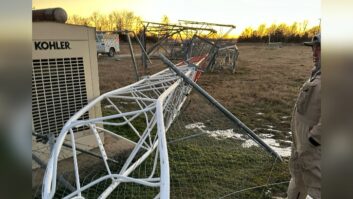I was settling in for a long winter’s nap — well, dozing during the January blizzard that lightly dusted the East Coast with two feet of snow — when the Nielsen Company’s highlights of its 2015 U.S. Music Year-End Report startled me awake.
Among the predictables are significant increases in music and video streaming and the delicious confirmation in the report that “Radio reaches more Americans than any other device or platform. Ninety-three percent of adult consumers (18+) use radio each week, more than TV (87 percent), smartphones (71 percent), PCs (54 percent), TV-connected devices (40 percent) and tablets (29 percent).”
But what confounded me, in this age of high-resolution audio, was that sales of the quaintly titled Vinyl LPs — you know, LPs as in long-playing and phonograph record — according to this report, achieved a new album sales record in of nearly 12 million units in 2015. The report says this is the 10th straight year of growth in vinyl sales, and that the rock music genre accounts for 68 percent of the album sales. (You can read it at http://tinyurl.com/rwee-nielsen.)

Was the purchase of a Gates CB-500 turntable plus accessories ($677 in 1973) an investment for the future? Just when I thought I could retire the Technics SP10-MKII and Stanton cartridge with calibrated weights for adjusting the tracking force, this report suggests to me, “Hey, grab your old records from the garage! Let’s have a dance party and spin some disks!” This resurgence of interest in analog recordings suggests radio stations could build an audience around a weekday evening program based on a disk jockey playing analog disks over the air. Extra audience points to stations that have the means to resuscitate their Gates CB-500 16-inch turntable, Micro-Trak tone arm and Shure M-44-7 stereo dynetic cartridge w/.0007-inch diamond stylus*, which are still packed, unloved, in the basement storage closet at the transmitter. (*Actual cost for this package from Gates in 1973, including the IC turntable preamplifier, was $677.45. That’s over $3,500 in 2016 dollars.)
On another end of the spectrum, high-resolution audio is generating interest in the automotive industry and with home enthusiasts.
This is audio that has been remastered to a linear format typically with a 24-bit depth and 96 kHz (or higher) sampling rate — or the analog master has been converted directly into several high-resolution formats. Some of the purveyors of downloadable hi-res audio files even offer a pedigree associated with the music to show its origin, and that the music isn’t just up-sampled or has zeroes stuffed where the extra bits should be.
Audiences seem to like the well-defined sound and clarity of these hi-res files and are willing to pay more for a high-quality file download. The sound quality is a pleasurable improvement over an MP3 file, and even more enjoyable than a CD-quality version.
One of the most visible companies in the high-resolution audio field is Neil Young’s PonoMusic, which sells its own oddly shaped PonoPlayer, perhaps the first portable audio player that looks like the offspring of an iPod that mated with a pyramid. The Pono website makes the company’s position clear: “The movement to save music from compressed formats has begun.”
The issue with hi-res music is now increased file sizes — not a big deal for a home Internet download, but the file sizes are a mobile-data-plan breaker, even when using lossless compressed formats like FLAC.
For instance, the free hi-res sampler download from HDTracks.com contains 11 music tracks and consumes 1.31 GB disk space. In the future, you may see some companies tout a proprietary lossless format that compresses hi-res audio for streaming; Meridian Audio has been promoting their Master Quality Authenticated format for that purpose.
There are several broadcast opportunities here.
One is for stations to play hi-res music files instead of MP3 and CD-quality. By an audio purists reasoning, the resulting air sound should be superior to playing lower resolution audio sources — and the listeners should notice and appreciate this.
Another but wackier thought is to create an HD Radio or RDS2 background delivery mechanism where the listener’s specialized HD Radio receiver gets a trickle download of a hi-res music track every so often. Admittedly, the trickle delivery would take a day or so for each track, but each music track would reach thousands of people in the coverage area at once, without using any wireless or Internet Service Provider.
A realistic summary of these points might be: Get some vinyl LPs and heavy-duty cabinetry to hold them, get some hi-res audio music tracks and a heavy duty hard drive to hold them, and put on a show!

TOWERING ABOVE US
On another topic: I have always enjoyed seeing broadcast towers day and night; each tower represents an achievement of civil engineering and risk management, and presents a view with aesthetically clean lines, slowly winking lights and sharply defined aviation paint colors.
As is well-known for almost a century, aviation and towers do not mix well, and the aviation paint, flashing lights and red beacons are a necessity to mark these obstructions to pilots — especially pilots who fly under Visual Flight Rules (VFR) and are not required to remain within a federal airway or designated air route.
The Federal Aviation Administration published Advisory Circular (AC) 70/7460-1L in late 2015 (discussed in a recent SBE webinar and well covered in Radio World) that change some of the recommended tower lighting standards. I was curious how these changes would affect the non-broadcast parties: the pilots.
I contacted the Aircraft Owners and Pilots Association about this new AC. The AOPA is a non-profit organization long dedicated to general aviation — the kind of flying you and I might do — and has been a staunch advocate of aviation safety and pilot training among its other aviation activities. AOPA’s Rune Duke, director of government affairs, airspace and air traffic, said the organization favors the changes in the new AC, and AOPA strongly encourages tower owners to meet the new standard due to the safety benefits they provide to aviation operations.
“The new Advisory Circular 70/7460-1L includes several positive changes that will improve aviation safety, such as the requirement for tower owners to inspect lenses every 24 months and additional reporting requirements for light outages,” Duke said. “Improving tower visibility is critical particularly for low altitude operators like agricultural aerial applicators and EMS helicopters. We believe the removal of steady burning L-810s on certain towers will not adversely impact safety and will greatly reduce bird deaths; however, we continue to work with the FAA on ensuring there is redundancy in the system so outages are mitigated and pilots are adequately cautioned.”
More information about AOPA, and about learning to fly, can be browsed at the association’s website aopa.org.
Got a thought about anything you see in Engineering Extra? Email me at[email protected].
Rich Rarey is RWEE technical editor and principal of Rareworks LLC consulting.











